- Yokohama-shi Top Page
- Health, Medical and Welfare
- Health and Medical Care
- institute for health
- Living Environment Hygiene Information
- Information on pests
- Be careful about the garden trees in May and June! (Chadokuga)
Here's the text.
Be careful about the garden trees in May and June! (Chadokuga)
Last Updated April 1, 2023
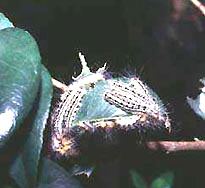
Larvae of chadokuga
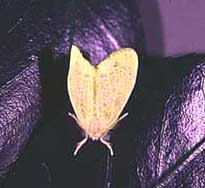
An adult chadokuga
Have you ever felt itching or pain when wearing the laundry you took in after caring for the garden trees? There are a lot of pests on the garden trees. Go down to the garden and look over.
Is there a camellia, sasanqua, etc. in the garden tree or near the laundry drying area? Camellia and Sasanqua have chadokuga as representative pests. The larvae of Chadokuga live in groups and eat leaves until they grow up.
If there are caterpillars eating leaves in groups, consider it a larvae of chadokuga. As you grow up, you will have a lot of black bumps on your back. There are countless venom needles there. When it is stabbed, venoms come out from inside. As the larva grows, it removes the outer skin. There are a lot of poisonous needles on the outer skin. It may fly in the wind.
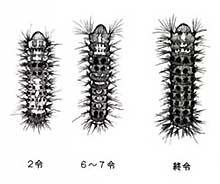
A larvae's poisonous needle
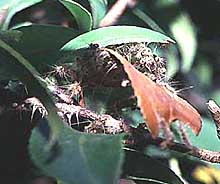
Chadokuga's shell
If it gets stuck
Drain tap water to the affected area vigorously. Hold it with a gum tape and repeat the peeling operation many times. Drain the tap water to the affected area again. Repeat this operation several times. If pain remains, red swelling, or eczema is formed, consult your doctor.
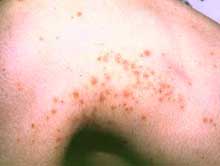
The affected area stabbed by Chadokuga
If you find it
Place a large bag under the branches with insects or under the leaves, and cut off the branches and leaves with insects into the bag. The caterpillars of the group will move away from the leaves and branches with slight vibrations and stimulation, and fall while pulling the thread, so work carefully. Caterpillars that have accidentally fallen out of the bag should be picked up with a stick and placed in the bag. Still, there may be left behind. Spray a cosm in the surrounding area.
- Reference-
Sawako Matsuzaki Kazuo Buei. Urban pests Encyclopedia
Tokyo: Asakura Bookstore 1993; 1-236.
(Explanation)
The adult wings (length of wings) are 12-14 mm for males and 15-18 mm for females. Female adults are pale yellow and have a yellowish-brown band pattern in the center of the foreground (front wing). There are one or two black spots on the front wing. The large larvae are about 25mm in length. The head is yellowish brown and the body is pale yellow. The larvae have the property of living together. However, they grow big and become separated before they become puddles. Once the outer skin is removed, the back of the larvae grows more poisonous hairs on the back of the larva. I see it twice a year. I spend the winter with eggs.
Larvae are found from May to June and from September to October. Touching larvae and detached outer skin causes severe pain and dermatitis. Adults may add poisonous hair to the end of the abdomen (the tip of the tummy) when they come out of the puddle. Adults flying on the light of the light may be exposed and drop the poison needle. It can also cause dermatitis by touching the poisonous needle. The larvae's food is a camellia plant such as cha, sasanqua, and camellia, which is very different from Dokuga, which eats a lot of plants. It is widely seen south of Honshu (Honshu, Shikoku, Kyushu).
- Diluted 10% daipeterex emulsion by 300 times and sprayed.
- Dilute 15% acephete emulsion by 200-300 times and spray.
- Dilute 20% ethofenprox emulsion by 4,000 times and spray.
Inquiries to this page
Microbial Inspection and Research Division, Medical Care Bureau Institute of Health
Telephone: 045-370-9379
Telephone: 045-370-9379
Fax: 045-370-8462
Email address: ir-eiken@city.yokohama.jp
Page ID: 678-989-989







